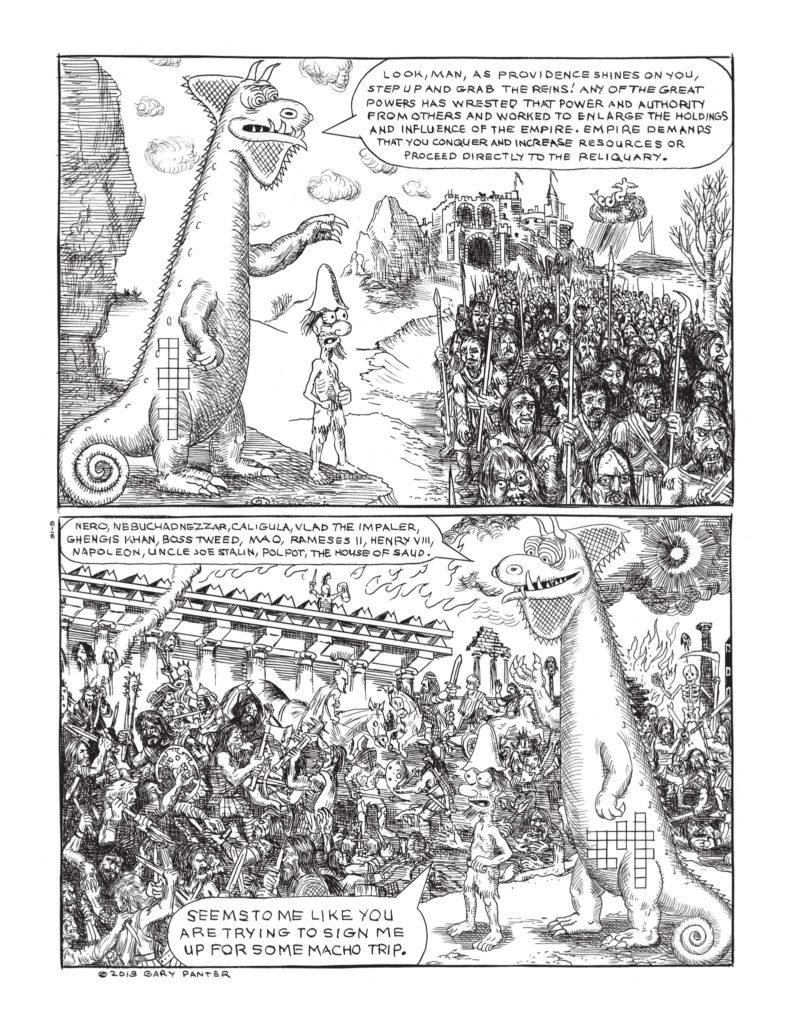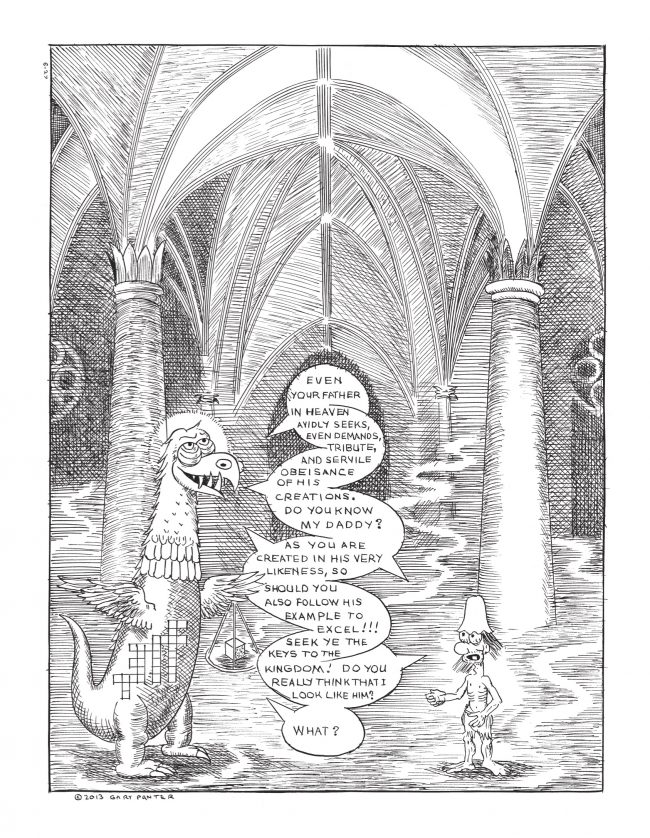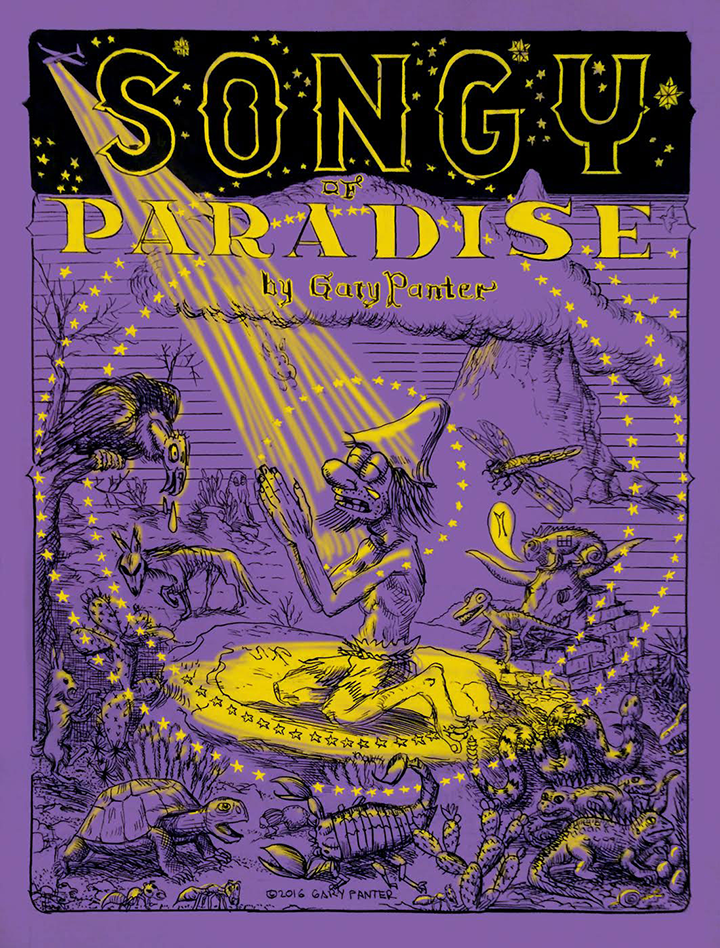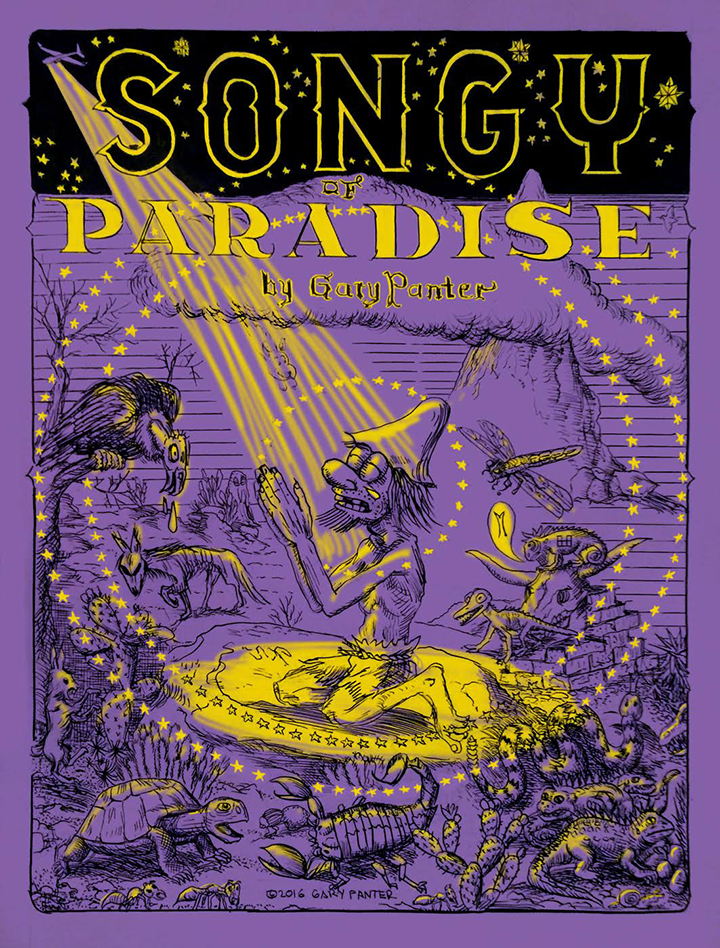I suppose it’s possible that I’m just showing my age here, but to me, the release of a new Gary Panter book still qualifies as a “drop everything” moment — especially when said book marks the concluding chapter of a long-running trilogy that’s followed a circuitous path from 1991 right up to the present day. So, yeah, when Fantagraphics Books dropped the long-awaited Songy Of Paradise this past Wednesday, it was indeed a very big deal.
Some quick background is no doubt in order for those not in the know: Panter began this story — or, rather, this series of interconnected stories — 26 years ago in the pages of his Jimbo series from Bongo Comics’ one-off (as in, created just for him) Zongo sub-label, but nobody (probably including the cartoonist himself) knew it was part of a larger, sprawling epic at the time. Fast-forward to 2004 and the release of Jimbo In Purgatory under Fantagraphics’ auspices, which appeared to be a stand-alone Jimbo graphic novel — until 2006, when Jimbo’s Inferno (also coming our way courtesy of FB) was unleashed upon the world, featuring material re-worked from the two stand-alone Jimbo “floppies” of (then) 15 years previous, and placed those comics within the framework established by the 2004 book.
Got all that? Okay, good — we’re all up to speed, then, but with a caveat: It’s really hard to say what the “first” part of this unnamed trilogy is. You could make a convincing argument for either of the prior installments being the first and/or second chapter, it’s true, but for our purposes it doesn’t really matter which side you come down on — we know what the third part is, and that’s what’s important.
Enter a new protagonist — stereotypical hillbilly simpleton Songy — and yet another new physical format: at 14.75 x 12 inches this is a damn big hardcover book (although not as big as Jimbo In Purgatory‘s 17.5 x 12 measurements), but at 32 pages it’s not an especially long one (by contrast, the aforementioned Purgatory ran 36). Other key differences abound as well, of course — the purposefully busy and cluttered art of both prior segments has been abandoned in favor of a cleaner, more “polished” (relatively speaking, mind you) look in this one, but make no mistake: The visual density hasn’t been “dialed back” in the least, and there’s still a ton to unpack in each and every panel here — it’s just that there are a lot fewer panels to dig in and analyze this time out due to Panter’s newfound affinity for big, bold, and highly detailed illustrations, up to and including splash pages. Likewise, the script here is a much more straightforward affair, sticking to a nearly note-for-note re-vamping of Milton’s famous 1671 poem “Paradise Regained” (a literal and thematic sequel to the even more famous “Paradise Lost”), albeit with Jesus’ role being assumed by our titular backwoods nitwit. No wholesale “borrowing” from disparate sources ranging from Joyce’s Finnegan’s Wake to a late-’60s magazine interview with then-contemporary supermodel Twiggy in this one — it’s all surprisingly, perhaps even disarmingly, straightforward stuff, at least at first glance.

All of which makes Songy Of Paradise something of a two-edged sword — it’s entirely accessible to “newbies” who haven’t read the previous two chapters, but one could also be forgiven, perhaps, for (mistakenly, as we’ll get to shortly) thinking there is less obvious “red meat” for long-time Panter readers/admirers to obsessively over-analyze. You can read this one without having your browser open to Google and get through it just fine — or so it would seem.
Satan, in his role as Christ/Songy’s great tempter, undergoes a slow and breathtaking visual transformation in these ingeniously-rendered pages, each new iteration littered with illustrative “clues” that are, in the best Panter fashion, head-scratchers to be sure, but generally easy enough to pin down — until they turn out to represent something else altogether. The best example is probably the ever-shifting crossword-puzzle motif visible on his many and varied forms, but in a recent TCJ interview with Dash Shaw, Panter reveals that those aren’t standard-issue empty “down” and “across” letter boxes at all, but actually symbols common in ancient Javanese manuscripts. So, ya know, there’s probably no such thing as knowing exactly what’s happening in a Gary Panter comic after all.

Which is a huge part of their appeal, of course. At 35 bucks, a book this slender (if gorgeous) had damn well better give you plenty to mull over, and there’s no doubt that this does: I’ve read it four times since buying it just over two days ago, and new elements — as well as new ways of interpreting previously-noted elements — reveal themselves each time, and easy answers are not just in short supply, they’re downright non-existent. Is Songy’s dipshit dialogue and general obliviousness a sign of his pure-hearted innocence, or of contemptible ignorance? Is he simply a stand-in for Christ, or for the author himself? Are the subtle changes Panter makes to Milton’s conclusion meant to make his “happy ending” ironic — or anything but?

I don’t have the answers, of course — only questions, and lots of them. And those questions deepen with each successive re-read. Songy Of Paradise is certainly a book that can be marveled at for its beautiful illustrations (many of which openly contradict aspects of Panter’s visual philosophy that he’s expounded upon in the past) and the lyrical quality of its script, but if you want to give it your full attention — as well you should — it’s a veritable puzzle-box of challenging concepts, expansive philosophical concerns, and metafictional extrapolations that will provide plenty of fuel for internal debates between yourself and your own preconceived perceptions for years on end. Panter has a well-earned reputation for being a good couple of decades ahead of all his peers in both the “fine” and “underground” art scenes (which is probably why he remains the most influential of just about any of ’em and has been able to move so effortlessly between the two), but the illusory simplicity in which he packages the undeniable complexity of this new book shows that he may now be moving a decade or two ahead of even himself. Multi-layered without being intimidating, endearing without being cloying, precise without being clinical, Songy Of Paradise is as close a thing to a working definition of a comics masterpiece as you’re ever likely to find.
Tags: Alternative Comics, Bongo Comics, Comic Books, Comics, Fantagraphics Books, Gary Panter, Jesus Christ, John Milton, The Devil, Twiggy, Zongo




No Comments